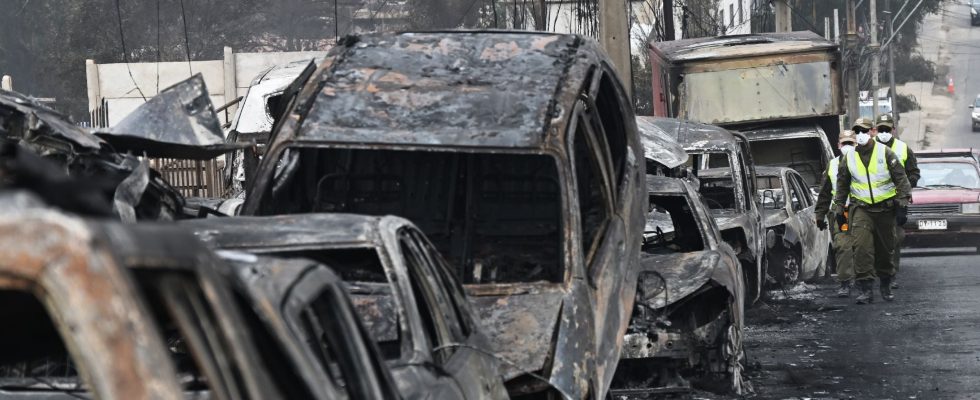Since Friday February 2, Chile has been plagued by violent fires. Entire residential areas devastated, cars burned, thousands of homes destroyed… In total, nearly 26,000 hectares were reduced to ashes. And the human toll continues to rise. In just a few hours, the death toll doubled from around 50 people to more than 100 dead in the Valparaíso region, in central Chile and about 120 kilometers north of the capital, Santiago. .
“We must say, with the information received from the forensic service that there are 112 people killed, 32 bodies identified,” said the spokesperson for the Ministry of the Interior, Manuel Monsalve, during a conference press release Sunday evening. Just a few hours after the declarations of Chilean President, Gabriel Boric, from a small town in the Valparaíso region, Quilpué, entire neighborhoods of which were charred. The Chilean head of state then announced 99 deaths, warning that their number would “increase significantly”.
Difficult to access areas
A toll which risks further increasing this Monday, while firefighters struggle to control the flames. Around forty outbreaks were still active on Sunday evening, located in difficult-to-access areas, according to the Reuters news agency. The seaside resort of Viña del Mar is particularly affected. Its mayor, Macarena Ripamonti, and the governor of the Valparaíso region, Rodrigo Mundaca, report around a hundred people missing.
“My neighbors were burned,” says Abraham Mardones, who miraculously managed to escape from Villa Independencia, described by our AFP colleagues as the epicenter of the fires ravaging this country of 19 million inhabitants. Some 12,000 people lived in this small town nestled on the heights of Viña del Mar, where the smell of ashes and burnt plastic still floats. According to estimates, between 3,000 and 6,000 houses were affected by the flames.
Lilian Rojas lived near the Viña del Mar botanical garden, an area also very affected by the fires. “There is not a single house left here,” she said, amid the rubble and ashes. This 67-year-old retiree was surprised by the speed of the flames. “I went outside to see and people were already running. I left my house, I closed the door and I left,” describes Lilian Rojas, who adds, showing her pink dress: “C It’s the only thing I have left.”
On Sunday evening, a curfew was established in four municipalities of Valparaíso, from 6 p.m. local time to 10 a.m. Monday, in order “to facilitate rescue operations for victims and recovery of the dead.”
The biggest tragedy since 2010
For the President of Chile, the observation is clear. “This is the biggest tragedy we have seen since the 2010 earthquake.” A direct reference to the 8.8 magnitude earthquake which was followed by a tsunami on February 27, 2010, causing more than 500 deaths.
Last year, 27 people died in forest fires, which are common during the summer in Chile. But, this year, “the number of hectares affected is increasing very quickly [malgré que] the area affected by the fires today [soit] much smaller”, noted the Minister of the Interior, Carolina Tohá, Saturday February 3. And to warn that fires which start near urban areas present “a very high potential to affect people , houses and facilities”.
Extreme temperatures
While pledging to “provide assistance in these difficult times”, the head of European diplomacy, Josep Borrell, deplored “devastating fires [qui] remind us of the ravages of drought and climate.” And for good reason, for several days, Chile has been facing scorching temperatures which are close to 40°C in the center of the country and the capital, Santiago. “These episodes are increasingly more recurrent, that’s why we see historic temperature records every year,” Pablo Lobos Stephani, in charge of fire protection at the National Forestry Company, explained to the Chilean branch of CNN.
Direct consequence of El Niño, which is characterized by the warming of the waters of the equatorial Pacific combined with atmospheric variations. However, this natural phenomenon, which adds to global warming, is currently hitting the southern cone of Latin America hard, and is favoring the outbreak of forest fires. Other neighboring countries of Chile could thus suffer from the devastating consequences of this heat wave which is suffocating South America. Among them, Argentina, Brazil, Uruguay and Paraguay, where temperatures reach up to 48°C.
This stifling heat is likely to settle in the region. The Uruguayan Institute of Meteorology (Inumet) has confirmed that the heat wave will last until February 9, with temperatures reaching 41°C. According to the Uruguayan news agency Merco Press, at least 36,000 homes have suffered power cuts, and 21 out of 24 territories are still on alert.
The capital of Argentina, Buenos Aires, has experienced record temperatures in recent days: 38.1°C, a first since February 12, 2023. In order to limit the risk of human losses, the health authorities encourage Argentines to consume between 2.5 and 3.5 liters of water per day. For their part, Paraguayan health authorities call on the population to avoid prolonged exposure to the sun and recommend the use of sunscreen and wearing light clothing between 10 a.m. and 5 p.m.
